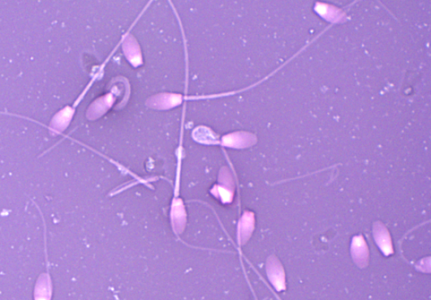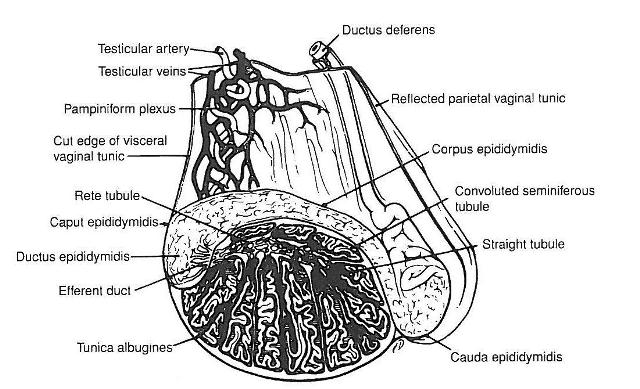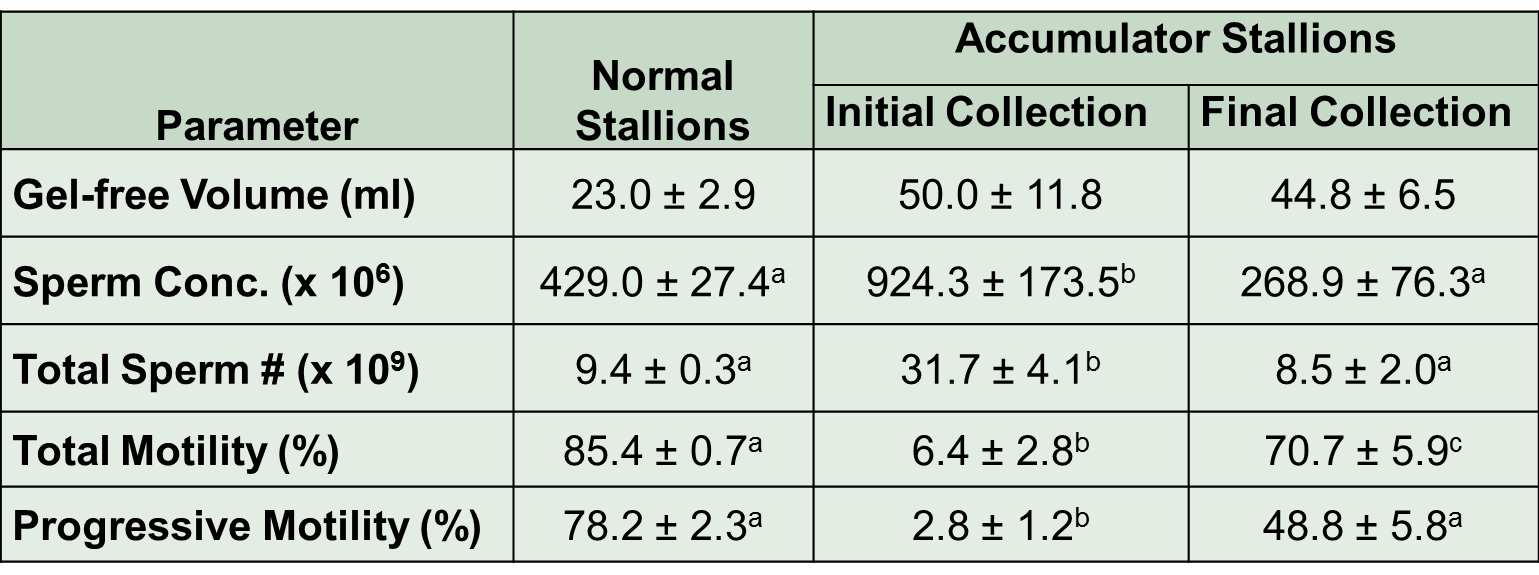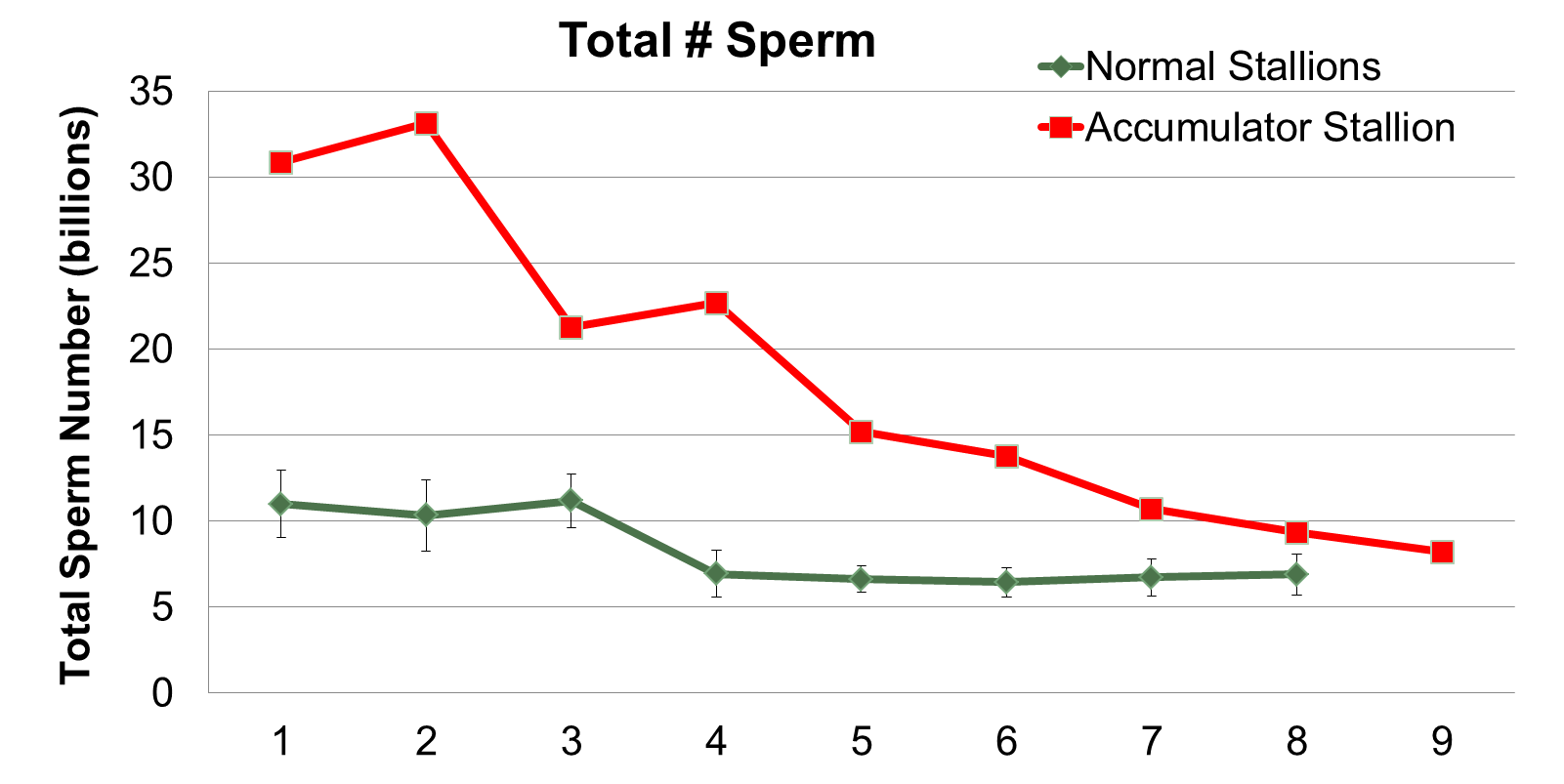 Have you ever wondered what happens to all those sperm the stallion produces every day (5 billion or more)? If he is not bred or collected then where do the sperm go? We know that sperm are produced in the testicle and move from the testicle into the efferent ducts and then into the head of the epididymis. It takes about 7-10 days for sperm to travel from the head of the epididymis to the cauda epididymis (tail; figure middle right). This time frame is not altered by how often the stallion ejaculates. The old wives tale that you can get immature sperm if the stallion is bred too often is just not true. In this article, Dr. Ed Squires and Dr. Pat McCue review the causes, diagnosis and treatment for stallions which accumulate sperm.
Have you ever wondered what happens to all those sperm the stallion produces every day (5 billion or more)? If he is not bred or collected then where do the sperm go? We know that sperm are produced in the testicle and move from the testicle into the efferent ducts and then into the head of the epididymis. It takes about 7-10 days for sperm to travel from the head of the epididymis to the cauda epididymis (tail; figure middle right). This time frame is not altered by how often the stallion ejaculates. The old wives tale that you can get immature sperm if the stallion is bred too often is just not true. In this article, Dr. Ed Squires and Dr. Pat McCue review the causes, diagnosis and treatment for stallions which accumulate sperm.
The tail of the epididymis is the major storage area for mature sperm along with the ductus deferens and ampullae. Under normal conditions if sperm are not removed by ejaculation they are thought to be emitted intermittently from the cauda epididymis, ductus deferens and ampullae into the pelvic urethra and voided in the urine. Besides ejaculation this is the primary way sperm are removed from the reproductive tract since resorption of sperm does not occur.
However, the problem comes when certain stallions accumulate an abnormal number of sperm in the ampullae. There are numerous terms used to describe the abnormal accumulation of sperm in the stallion’s tract: sperm accumulator, spermiostasis, plugged ampullae. Interestingly, though it has been described in the literature for over 25 years, there have been very few studies done on the issue. Most of the information is based on clinical cases and presented in text books.
Cause
 It is safe to say no one has determined a definitive cause of this condition in stallions but it is estimated to affect 30-40% of stallions to some degree. McCue et al. suggests the cause could be a dysfunction in contraction of the smooth muscles of the reproductive tract, abnormal fluid environment, or dysfunction/blockage of the seminal colliculus. Turner et al. stated that there did not appear to be a breed or age effect on the incidence of this condition but that stallions with one testicle may be more prone to the condition and that spermiostasis seems to be more common early in the year after stallions have had a long period of sexual rest.
It is safe to say no one has determined a definitive cause of this condition in stallions but it is estimated to affect 30-40% of stallions to some degree. McCue et al. suggests the cause could be a dysfunction in contraction of the smooth muscles of the reproductive tract, abnormal fluid environment, or dysfunction/blockage of the seminal colliculus. Turner et al. stated that there did not appear to be a breed or age effect on the incidence of this condition but that stallions with one testicle may be more prone to the condition and that spermiostasis seems to be more common early in the year after stallions have had a long period of sexual rest.
Diagnosis
Diagnosis is based on the sperm numbers and quality of the sperm in the ejaculate plus rectal palpation and ultrasound of the ampullae. Occasionally, the ejaculate of the stallion contains no sperm even though the testis are of normal size and the tail of the epididymis is also of normal size. This can be quite confusing since the cause of no sperm in the ejaculate could be due to the testes not producing sperm, the ampullae are “plugged," or the stallion not ejaculating. This can generally be solved by running an assay on the seminal fluid for the enzyme alkaline phosphase. If this value is below 100 IU then there is complete blockage and no contribution from the testis and epididymis is occurring.
More commonly the ejaculate contains either very large numbers of sperm or the sperm numbers are quite variable from one ejaculate to another. Pickett and others at Colorado State University in 1989 presented an example of a stallion that was collected 5 times in one day at hourly intervals.  The first ejaculate contained an extremely high number of sperm (60.8 billion) and it was not until the 5th ejaculate that numbers were in the normal range (8.4 billion). This horse had a history of settling mares when pasture bred where he ejaculated frequently but fertility was low when he was hand mated.
The first ejaculate contained an extremely high number of sperm (60.8 billion) and it was not until the 5th ejaculate that numbers were in the normal range (8.4 billion). This horse had a history of settling mares when pasture bred where he ejaculated frequently but fertility was low when he was hand mated.
When large numbers of sperm are stored in the ampullae the motility of the sperm upon ejaculation is quite low due to the high temperature the sperm are exposed to when stored too long in the ampullae. Ejaculates of stallions that accumulate sperm generally contain sperm with low motility and abnormalities such as detached heads (Photo top left). Sperm concentration is also abnormally high resulting in large numbers of sperm per ejaculate. Degenerate sperm are sometimes ejaculated in clumps or casts.
An ultrasound exam should always be part of the panel of techniques used to diagnosis this condition. Ampullae that are impacted with sperm will contain a large amount of hyperechoic material, an echolucent lumen and the glands will be enlarged. The ultrasound should always be combined with palpation per rectum. The size and tone of the ampullae can be determined by palpation and the response to treatment can be assessed by palpation and ultrasound.
Treatments
Most of the reports in the literature have focused on clinical treatments for sperm accumulators. These include something as simple as frequent palpation, massage of the ampullae per rectal palpation, frequent breeding and collections. One approach is to allow the stallion to breed the “jump” mare several times or other mares then collect semen from the stallion after he is “cleaned out.” This may be done for several days with or without the addition of agents to stimulate smooth muscle contractions, such as oxytocin (10-30 IU) and PGF2 alpha (25-125 ug) or a PGF2 alpha analogue.
 A recent study by McCue et al. at Colorado State University included 10 normal stallions and 10 client owned-stallions with a history of sperm accumulation. Criteria for inclusion as sperm accumulators included: high sperm concentration, abnormally high sperm numbers, and low total sperm motility in the initial collection with improvements with subsequent ejaculations. Client stallions were collected as needed until concentration of sperm and total motility became normal. Data on the initial and final collections for both groups of stallions are in the table above. As shown in the graph above, total sperm numbers decreased in accumulators over the nine collection days. Whereas total motility of the sperm in the accumulators increased after 3 ejaculations. It took 8.9 collections (range 3 to 20) over 7.1 days (range 2 to 20) for accumulators to have normal semen values. However, as has been seen in many studies when these stallions were given several days of sexual rest the motility of the sperm once again declined.
A recent study by McCue et al. at Colorado State University included 10 normal stallions and 10 client owned-stallions with a history of sperm accumulation. Criteria for inclusion as sperm accumulators included: high sperm concentration, abnormally high sperm numbers, and low total sperm motility in the initial collection with improvements with subsequent ejaculations. Client stallions were collected as needed until concentration of sperm and total motility became normal. Data on the initial and final collections for both groups of stallions are in the table above. As shown in the graph above, total sperm numbers decreased in accumulators over the nine collection days. Whereas total motility of the sperm in the accumulators increased after 3 ejaculations. It took 8.9 collections (range 3 to 20) over 7.1 days (range 2 to 20) for accumulators to have normal semen values. However, as has been seen in many studies when these stallions were given several days of sexual rest the motility of the sperm once again declined.
Management
- Frequent “clean-out” collections or breedings prior to collecting semen for breeding on the farm or cooling or freezing
- Regular/scheduled collections or breedings throughout the breeding season at appropriate intervals to keep the stallion “cleaned-out”
- If the ampullae are blocked then frequent collections, massage of the ampullae per rectum and the administration of oxytocin or prostaglandins may be indicated
_____________________________________________________________________________________________
References
Spermiostasis in Stallions: A Retrospective Study of Clinical Cases P.M McCue, C.F. Scoggin. D.. Moffett, C.A. Burden, R.A. Ferris Journal of Equine Veterinary Science 34:47, 2014
Alkaline Phosphatase in Stallion Semen: Chacterization and Clinical Applications Turner RMO,McDonnell SM Theriogenology 2003;60:1-10
Ultrasonography of the Genital Tract Regina M.O. Turner Equine Reproduction second edition AO Mckinnon,Edward Squires,Wendy Vaala and Dickson Varner pg1483-1485,2013
Frequency of Ejaculation in Management of the Stallion for Maximum Reproductive performance, II Pickett,BW,Amann,RP McKinnon,AO,Squires EL and Voss JL Colorado State University Animal Reproduction Laboratory Bulletin No. 5 pg 79-80





